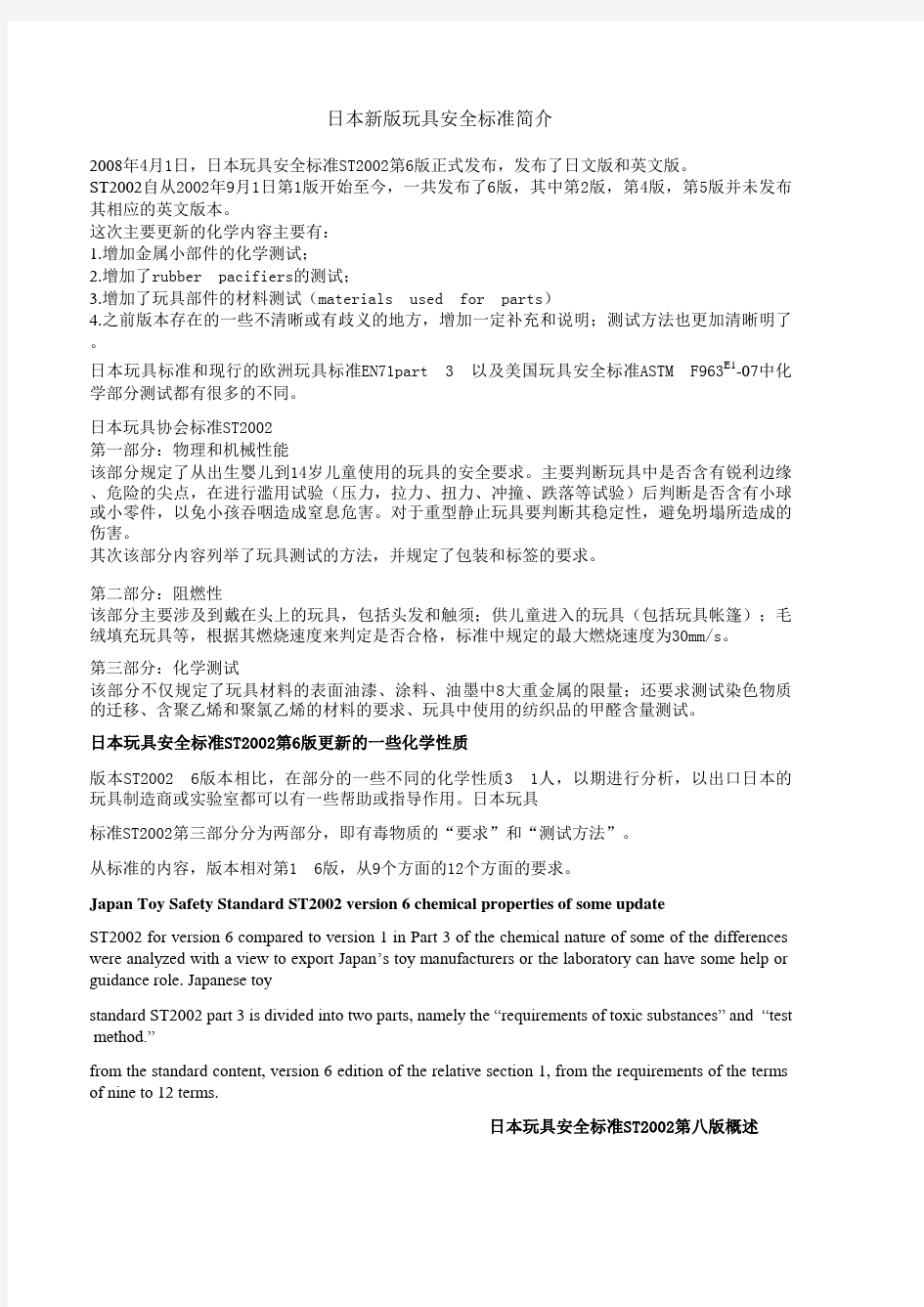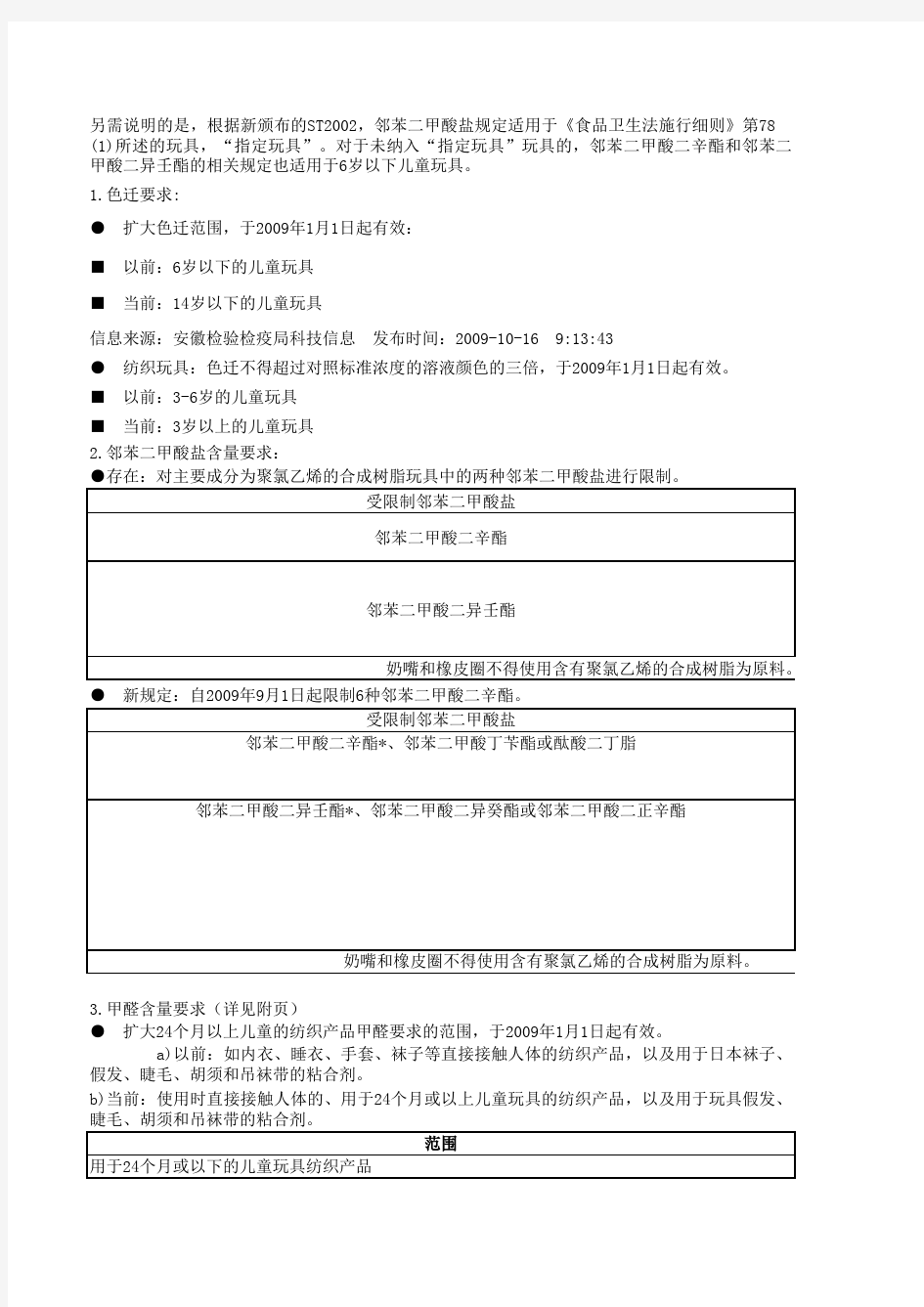日本新版玩具安全标准简介


日本新版玩具安全标准简介
2008年4月1日,日本玩具安全标准ST2002第6版正式发布,发布了日文版和英文版。
ST2002自从2002年9月1日第1版开始至今,一共发布了6版,其中第2版,第4版,第5版并未发布其相应的英文版本。
这次主要更新的化学内容主要有:
1.增加金属小部件的化学测试;
2.增加了rubber pacifiers的测试;
3.增加了玩具部件的材料测试(materials used for parts)
4.之前版本存在的一些不清晰或有歧义的地方,增加一定补充和说明;测试方法也更加清晰明了。
日本玩具标准和现行的欧洲玩具标准EN71part 3 以及美国玩具安全标准ASTM F963E1-07中化学部分测试都有很多的不同。
日本玩具协会标准ST2002
第一部分:物理和机械性能
该部分规定了从出生婴儿到14岁儿童使用的玩具的安全要求。主要判断玩具中是否含有锐利边缘、危险的尖点,在进行滥用试验(压力,拉力、扭力、冲撞、跌落等试验)后判断是否含有小球或小零件,以免小孩吞咽造成窒息危害。对于重型静止玩具要判断其稳定性,避免坍塌所造成的伤害。
其次该部分内容列举了玩具测试的方法,并规定了包装和标签的要求。
第二部分:阻燃性
该部分主要涉及到戴在头上的玩具,包括头发和触须;供儿童进入的玩具(包括玩具帐篷);毛绒填充玩具等,根据其燃烧速度来判定是否合格,标准中规定的最大燃烧速度为30mm/s。
第三部分:化学测试
该部分不仅规定了玩具材料的表面油漆、涂料、油墨中8大重金属的限量;还要求测试染色物质的迁移、含聚乙烯和聚氯乙烯的材料的要求、玩具中使用的纺织品的甲醛含量测试。
日本玩具安全标准ST2002第6版更新的一些化学性质
版本ST2002 6版本相比,在部分的一些不同的化学性质3 1人,以期进行分析,以出口日本的玩具制造商或实验室都可以有一些帮助或指导作用。日本玩具
标准ST2002第三部分分为两部分,即有毒物质的“要求”和“测试方法”。
从标准的内容,版本相对第1 6版,从9个方面的12个方面的要求。
Japan Toy Safety Standard ST2002 version 6 chemical properties of some update
ST2002 for version 6 compared to version 1 in Part 3 of the chemical nature of some of the differences were analyzed with a view to export Japan’s toy manufacturers or the laboratory can have some help or guidance role. Japanese toy
standard ST2002 part 3 is divided into two parts, namely the “requirements of toxic substances”and “test method.”
from the standard content, version 6 edition of the relative section 1, from the requirements of the terms of nine to 12 terms.
日本玩具安全标准ST2002第八版概述
针对ST2002第6版相对于第1版第3部分化学性质的部分差异进行对比分析,以期能对出口日本的玩具生产商或实验室能有一些帮助或指引性作用。
日本玩具标准ST2002 part 3分为两部分,分别是"有毒物质的要求"和"测试方法"。
从标准内容方面,第6版相对第1版,由之前的要求的9个条款增加到12个条款.
为了提高玩具的安全性,日本玩具协会已经为专门针对14岁及14岁以下儿童使用的玩具制定了“玩具安全标准(ST)”。S代表安全,T代表玩具。该标准为自愿性质的,符合该标准的产品才被允许在产品本身打上ST标志。ST标志系统还包括了受害者赔偿条款,以备标有ST标志的产品被投诉对消费者造成伤害时作出赔偿。在市场中携带该标志的产品必须在注册后每年都进行更新。一个产品的ST标志的有效期为四年,此后必须重新进行测试才能继续携带该标志。
日本玩具标准在1971年由日本玩具业及日本政府、学者、消费者代表共同制定。2002年的修订版本参照及合并了国际标准如ISO及日本食品卫生法的要求。
日本玩具标准(ST2002)适合于14岁及以下的儿童玩具,包括18个月以下的儿童玩具要求,3岁以下的儿童玩具要求和10岁以下的儿童玩具要求。
包括:
1、驱动玩具
2、科学器材
3、儿童工艺品(例如:容易搭建的模型,木工工具)
4、花园玩具(例如:千秋)
5、玩具运动器具
6、水上玩具
7、浴池玩具
8、用于水面上的充气玩具
9、圣诞节用品
10、用于手机上的带
但不包括下面的产品:
1、赛璐珞桌球,及包括此类的套装产品
2、体育场共同使用或用于个别培训的运动器械
3、运动场共同使用的器械
4、深水中使用的水上器材、船、气床,救生艇及类似的足以支撑儿童的漂浮物
5、压缩气体的武器
6、烟花爆竹
7、内燃机车
8、成人搜集的仿真比例模型
9、投石器和弹弓
10、以传动驱动后轮,无论其是否安装稳定器,最大座位高度大于435mm且小于635mm的儿童自行车
11、连接到电视机的视频玩具/游戏
12、座位高度超过33 cm的骑乘玩具
13、防护眼镜,潜水通气管,(潜水)鸭脚板,手臂圈/环,游泳衣,冲浪板,但不包括充气的塑胶产品
14、使用液体或固体燃料的玩具
15、使用内燃机的玩具
16、棒球棒
17、带有金属尖头的飞镖/标枪
18、对人体造成伤害的激光及发光体
19、活的生物(种子及类似物),及包含活生物套装产品
20、同玩具一起售卖的食品,例如作为玩具的奖品放在糖盒里的糖果(只测试玩具)
Only after nine months from publication of the sixth edition of the Japan Toy Safety Standard (ST2002), the Japan Toy Association announced on 28 November 2008 about amendment of the Standard for the seventh time. Toys that apply for the ST Mark of the Japan Toy Association (JTA) shall follow and comply with the new standard on or after 1 January 2009. The change relates only to Clause 1.1 of the standard where colouring matters that are produced by chemical synthesis and used on toys. shall be selected from those substances as listed in Schedule 1 of the Food Sanitation Law Enforcement Regulations of Japan or colour migration should not be observed after testing. This requirement shall become applicable to:
(1) Toys intended for children of 14 years old and under (instead of “toys intended for
children under 6 years of age” in previous edition);
(2) Exception is allowed for textile on toys intended for children over 3 years of age (instead of “over 3 years of age and under 6 years of age”in previous edition) where migration of colour should not be deeper than the colour of the solution which is three time as dense in concentration as the comparison standard.
The lately change of the ST standard again brings in line with the latest interpretation of Food Sanitation Law of Japan which has been effective on 1 October 2008.
While the Food Sanitation Law is applicable to designated toys that are intended for infants and preschool children (children under six years of age), it shall also be applicable to toys intended for higher age groups if there are possibilities that the toys may cause damage to the health of children under six.
Typical toy examples that fall in this category and subject to the legislative requirements include, but not limited to, transformer toys, mechanical animal robots, board games with small accessories, trading cards with printed cartoon characters and food imitation toys.
The new Japan Toy Safety Standard now covers a wider range of toy categories on toy safety up to 14 years of age. This coupled with additional requirements including 8 toxic elements testing for paint coatings and prohibition of both DEHP & DINP in PVC items for children under three have made the standard more stringent than the Food Sanitation Law. Toys therefore complying with the new Japan Toy Safety Standard shall be deemed to comply with the Food Sanitation Law as well.
